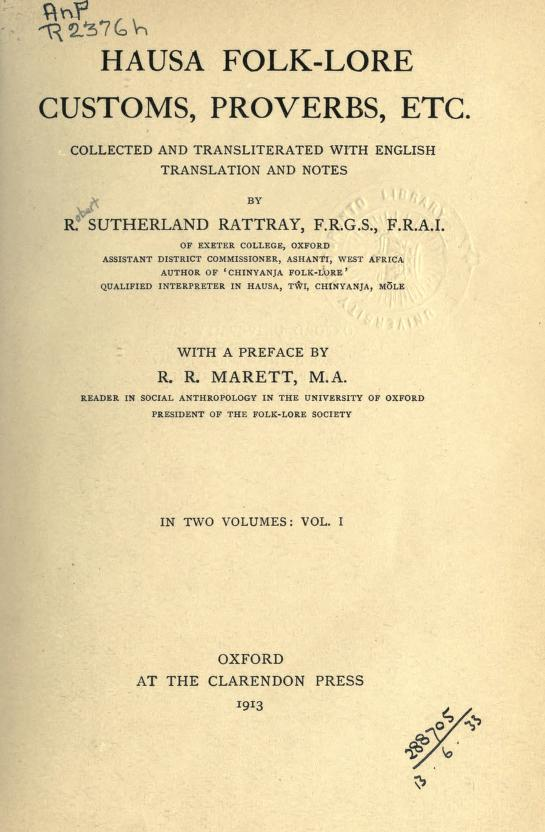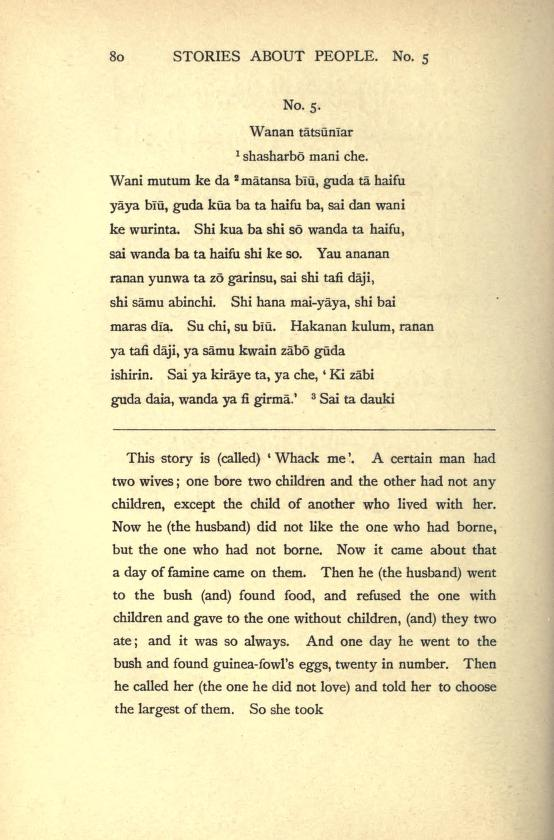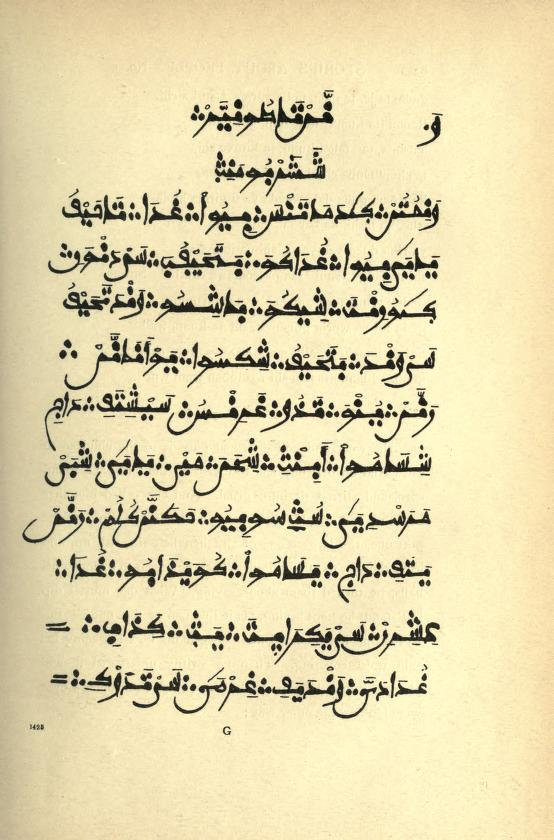Title of the work
Country of the First Edition
Country/countries of popularity
Original Language
First Edition Details
Robert Sutherland Rattray, "How the Whip and the Maara Spoon (a Broken Bit of Calabash) Came to the Haunts of Men” in Hausa Folk-Lore: Customs, Proverbs, etc. Collected and Transliterated with English Translation and Notes. Vol. 1, Oxford: Clarendon Press, 1913, 80–107.
Available Onllne
How the Whip and the “Maara” Spoon (a Broken Bit of Calabash) Came to the Haunts of Men (accessed: July 9, 2021).
Genre
Folk tales
Target Audience
Crossover
Cover

Retrieved from Internet Archive (accessed: July 9, 2021).
Author of the Entry:
Chester Mbangchia, University of Yaoundé 1, mbangchia25@gmail.com
Peer-reviewer of the Entry:
Daniel A. Nkemleke, University of Yaoundé 1, nkemlekedan@yahoo.com
Susan Deacy, University of Roehampton, s.deacy@roehampton.a.uk
Marta Pszczolińska, University of Warsaw, m.pszczolinska@al.uw.edu.pl

Robert Sutherland Rattray
, 1881 - 1938
(Author)
Robert Sutherland Rattray (1881–1938) was born in India. He was a Scottish anthropologist and an authority on the native peoples of West Africa. He was educated at Exeter College at Oxford University and held a diploma in anthropology. In 1902 he entered Civil Service in Africa, first, in British Central Africa and from 1907, on the Gold Coast. During the Great War he served in Togoland and received the MBE, in 1929, he was progressed to CBE. In each place he was sent to, he studied local languages and conducted anthropological research about folklore, religion, beliefs, customs, law, art, folktales and proverbs. In 1924 he was made head of the Anthropological Department in Ashanti/Asante in acknowledgment of his merits. His contribution to the detailed study of the Ashanti customs and folklore was based on personal observations, contacts with the Ashanti, and a thorough knowledge and understanding of their culture. On his retirement, R. S. Rattray was a lecturer of anthropological topics at Oxford and elsewhere. He was passionate about flying, one of the first to fly to West Africa, a pioneer of gliding. He founded a club of gliding at Oxford and a week later was killed in a glider flying accident.
His main works include: Some Folk-Lore Stories and Songs in Chinyanja: with English Translations and Notes (1907), Hausa Folk-Lore, Customs, Proverbs, etc.: Collected and Transliterated with English Translation and Notes (1913), Ashanti Proverbs: the primitive ethics of a savage people: translated from the original with grammatical and anthropological notes (1916), An Elementary Mōle Grammar with a Vocabulary of Over 1000 Words for the Use of Officials in the Northern Territories of the Gold Coast (1918), Ashanti (1923), Ashanti Law and Constitution (1929), Akan-Ashanti Folk-tales (1930), The Tribes of the Ashanti Hinterland (1932), The Golden Stool of Ashanti: a Sacred Shrine Regarded as a Symbol of the Nation's Soul, and Never Lost or Surrendered, Its True History, a Romance of African Colonial Administration (1935).
Source:
“Captain R. S. Rattray, C. B. E.”, Nature 3577.141 (1938): 904, 929. (accessed: July 2, 2021).
Bio prepared by Marta Pszczolinska, University of Warsaw, m.pszczolinska@al.uw.edu.pl

Maalam Shaihu (Author)
Maalam Shaihu (active in the early twentieth century) was one of the learned Hausas known as maalamai, who were the most respected and honoured members of the Hausa community in the Gold Coast and Nigeria. The use of Arabic corresponded at that time to the use of Latin in mediaeval Europe, the knowledge of Arabic was necessary for conducting any research about the Hausa culture. A maalam of the best class possessed all the language and literary skills and understanding of the Hausas. Thus, Shaihu cooperated with R. S. Rattray to gather Hausa stories and manuscripts and make the Hausa culture better known. Much of the work contained in Hausa Folk-Lore involved his translation from Arabic into Hausa, and Rattray’s translation into English from the Hausa. In 1907-1911 during Rattray’s journeys in West Africa and in England, Maalam Shaihu accumulated many hundreds of sheets of manuscripts. Thanks to his work the traditional lore lost nothing of its authenticity. It is worth mentioning that, by the grant of the government of the Gold Coast, Maalam Shaihu’s Arabic penmanship was preserved by facsimile reproduction of his Arabic text printed in the 1913 edition.
Source:
R. R. Marett, Preface; R. Sutherland Rattray, Author’s Note in R. S. Rattray, Hausa Folk-Lore, Oxford: Clarendon Press, 1913.
Bio prepared by Marta Pszczolińska, University of Warsaw, m.pszczolinska@al.uw.edu.pl
Summary
A man had two wives: one of whom had children and the other who did not but stayed with an adopted child. The man despised the wife with whom he had children. Whenever there was hunger, he went to the bush and brought food for the childless wife. One day, he went to the bush, found twenty guinea-fowl eggs, and gave the largest to the wife with children. She boiled it and gave it to her children. Another day arrived, and the woman with children went to the bush and brought corn, which she stirred into gruel. Before giving some to her husband, she instructed him to dip his largest fingernail into the pot of soup. He disrespected her instructions by dipping in his hand. In response, she told him he was to be punished for his disobedience. When she went to the bush the next day, she found a "maara" spoon (a broken bit of calabash) and did not greet it. The spoon reprimanded her, and she eventually greeted it. When she inquired about its name, it said it was called "Help me". The spoon told her to say, "Help me that I may taste." When she did, it filled her calabash with much food. She arrived home and served her husband the food. He ate and felt good. She did the same thing for two days, and one day, he asked to see where she routinely got the food.
When they went to the bush, she instructed her husband to say the same thing she had spoken to the spoon. He did, and the same result followed. While returning, he took the spoon home and kept it in his grain store. When the wife he loved was hungry, he instructed her to speak to the spoon, which also gave her a lot of food. One day she took the spoon to the stream in the bush, and as she started washing it, the chief's wife came and admired the spoon. When she spoke to it, the spoon gave her food too, so she took it to the chief, her husband. The chief consumed the food, was satisfied and asked to see the spoon. When his wife brought it to him, he claimed it, saying its services were not for the poor but the rich like him. And thus, the man with two wives lost the spoon. In his house, there was now hunger and the wife, whom he did not love, went to the bush and found a whip there. When she greeted it and asked about its name, it said it was "Whack me", and the woman called it thus. She subsequently told the whip, "Whack me that I may feel" and it flogged her till people came to her rescue. She went home, took her husband to the same location, and asked him to repeat what she had said to the whip. He did and was flogged.
When he got home, tired, he concealed this incident from the wife he loved. The next day, he brought the whip to the house and put it in the grain store. His favourite wife came to him, complaining of hunger, so he sent her to the grain store where he kept the whip. He asked her to greet it and inquire about its name. As she carried out the instruction, it whipped her. Her weeping terrified her husband, and he escaped to the forest. His two wives followed him and left the house deserted. From that day, the whip and the spoon remained among humans and never returned to the forest again.
Analysis
This myth accentuates the concepts of justice and kind-heartedness, which are typical ingredients for children's and young adult literature. These very traits are seen in the woman who was unloved in the myth and accurately reflect most epic heroines' chief characteristics. There is, in addition, the ethical issue of social justice or divine retribution, which is enforced by the spirit that acts through the "Whack Me". Lastly, magical objects and animals appear in many myths around the world. Generally, they are linked with those that use them and those that find themselves around the objects. The justice in "Whack Me", for example, transmits the same type of equilibrium brought by the ostrich egg in the South African myth where a man finds it and carries it to the house, and it becomes the source from which his wife emerges and makes him chief in his village. In the context of the myth above, the whip helps in dealing out justice in society and portraying the vaulting nature of human ambitions. "Whack Me" can thus be a great source of cultural entertainment for young learners on not only its thrilling plotline and dramatic incidents but also on its didactic nature.
Further Reading
Florence, Namulundah, "Female Role Models in Bukusu Folktales: Education at the Mother’s Hearth", Cogent Education 3.1 (2016), DOI: 10.1080/2331186X.2016.1185238
Knappert, Jan, Myths and Legends of Botswana, Lesotho, and Swaziland. Vol. 14, Leiden: Brill Archive, 1985.
Salm, Steven J., and Toyin Falola, Culture and Customs of Ghana. Westport, Conn.:Greenwood Publishing Group, 2002.
Addenda
Although these myths were collected so many years ago, they are still being told to children and young adults in traditional African communities. And like all other oral narratives, several versions of the same story may be available in different places.
The first edition of Hausa Folk-Lore was published in English by Oxford Clarendon Press, providing, however, the text of the stories in three languages simultaneously: Hausa, English and Arabic as it was an academic publication aimed at anthropologists, students and Hausa language learners (especially that it contains pronunciation tables at the beginning, and some notes with vocabulary and grammar at the end of vol. 2).
Even though Rattray aimed his book at students of the Hausa language and anthropologists, after his death it was republished many times without Hausa and Arabic text as the interesting Hausa stories to be told, while the oral versions of the folk tales were still alive. It shows two parallel ways of the reception of these folktales and this is a phenomenon which is worth being highlighted.


Scans retrieved from Internet Archive (accessed: July 5, 2021).


